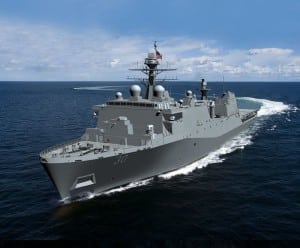The Senate Armed Services Committee’s draft FY ’21 defense authorization bill seeks to prevent the Defense Department from listing a purchase year on a ship different from what Congress previously approved, as happened this year.
The Navy’s FY ’21 budget request listed the San Antonio-class Flight II landing platform dock LPD-31 as designated in the current budget plan, but Congress previously funded and authorized the ship in the FY ’20 budget, drawing particular criticism from House authorizers claiming this inflated the new ship count (Defense Daily, Feb. 26).

In April, the Navy awarded Huntington Ingalls Industries [HII] a $1.5 billion modification to procure the detail design and construction for LPD-31 (Defense Daily, April 3).
The budget request also listed the future Gerald R. Ford-class carrier CVN-81 as procured in FY ’20 instead of FY ’19 when it was approved a part of the two carrier buy and listed the future America-class amphibious assault ship LHA-9 as projected for procurement in FY ’23 instead of procured in FY ’20.
The FY ’20 defense appropriations bill added $650 million to incrementally fund LHA-9, but in February the Trump administration sent a reprogramming request to move funds from the LHA to the border wall project (Defense Daily, Feb. 13).
The new provision reads that “a procurement quantity of a system authorized by Congress in a National Defense Authorization Act for a given fiscal year that is subsequently appropriated by Congress in an amount greater than the quantity of such system included in the President’s annual budget request submitted to Congress under section 1105 of title 31, United States Code, for such fiscal year shall not be included as a new procurement quantity in future annual budget requests.”
The SASC bill report explained this would “preclude the inclusion in future annual budget requests” of a procurement system previously authorized and appropriated in this way, like LPD-31 and the other ships.
The report said “the committee is concerned” that presenting LPD-31 as an FY ’21 ship instead of procured in FY ’20, CVN-81 presented procured n FY ’20 instead of FY ’19, and LHA-9 as projected for FY ’23 instead of procured n FY 20 DoD “is disregarding or mischaracterizing the actions of Congress regarding the procurement dates of these three ships.”
This provision comes after a Congressional Research Service report on June 8 explained “the Department of Defense’s decision to present LPD-31 and LHA-9 as ships requested for procurement in FY2021 and FY2023, respectively, even though Congress procured both ships in FY2020, poses a potentially significant institutional issue for Congress regarding the preservation and use of Congress’s power of the purse under Article 1 of the Constitution, and for maintaining Congress as a coequal branch of government relative to the executive branch.”
The report noted the institutional issue suggests questions about if DoD did this to inflate the apparent number of ships requested for FY ’21 procurement and ships in the five-year shipbuilding plan and if this could establish precedent for DoD to disregard or mischaracterize the actions of Congress regarding the procurement or program initiative dates for other Navy or overall federal programs.
“If so, what implications might that have for the preservation and use of Congress’s power of the purse under Article 1 of the Constitution, and for maintaining Congress as a coequal branch of government relative to the executive branch?” the report asked.